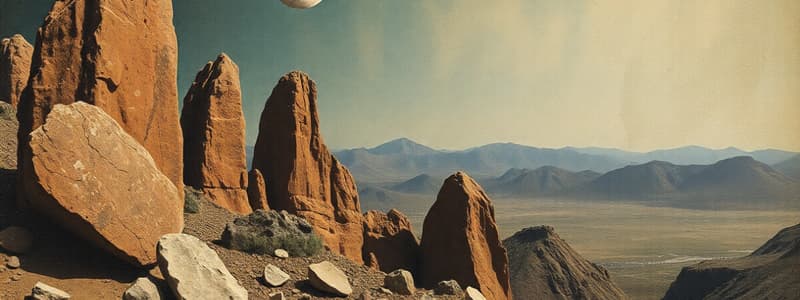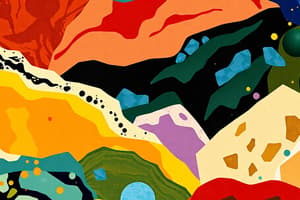Podcast
Questions and Answers
What type of chemical bond forms between oppositely charged ions such as sodium and chlorine?
What type of chemical bond forms between oppositely charged ions such as sodium and chlorine?
- Covalent bond
- Metallic bond
- Hydrogen bond
- Ionic bond (correct)
How many naturally occurring elements are abundant in the Earth's crust, according to the information provided?
How many naturally occurring elements are abundant in the Earth's crust, according to the information provided?
- 4
- 92
- 118
- 8 (correct)
What is the name of the charged particle formed when an atom gains or loses electrons?
What is the name of the charged particle formed when an atom gains or loses electrons?
- Atom
- Molecule
- Element
- Ion (correct)
What element is represented by the chemical symbol 'Au'?
What element is represented by the chemical symbol 'Au'?
Which two elements form the basis of the silicon-oxygen tetrahedron found in silicate minerals?
Which two elements form the basis of the silicon-oxygen tetrahedron found in silicate minerals?
Which statement accurately describes a key characteristic of minerals?
Which statement accurately describes a key characteristic of minerals?
What distinguishes igneous rocks from other types of rocks?
What distinguishes igneous rocks from other types of rocks?
What is the atomic number of an element determined by?
What is the atomic number of an element determined by?
Which of the following minerals is categorized as part of 'the Big Ten'?
Which of the following minerals is categorized as part of 'the Big Ten'?
What is the primary element found in silicate minerals?
What is the primary element found in silicate minerals?
Which of the following is NOT considered a sphere of Earth?
Which of the following is NOT considered a sphere of Earth?
Which statement accurately describes Earth materials?
Which statement accurately describes Earth materials?
Which of the following is part of the lithosphere?
Which of the following is part of the lithosphere?
What is a key characteristic that disqualifies a substance from being classified as a mineral?
What is a key characteristic that disqualifies a substance from being classified as a mineral?
Which of the following substances is classified as a mineral despite being liquid at room temperature?
Which of the following substances is classified as a mineral despite being liquid at room temperature?
Flashcards
Isotopes
Isotopes
Atoms of the same element with different neutron counts.
Minerals
Minerals
Natural compounds formed by chemical bonding of elements.
Ionic Bond
Ionic Bond
A chemical bond formed by electron transfer between ions.
Cation
Cation
Signup and view all the flashcards
Silicate Minerals
Silicate Minerals
Signup and view all the flashcards
Mineraloids
Mineraloids
Signup and view all the flashcards
The Big Ten Minerals
The Big Ten Minerals
Signup and view all the flashcards
Atomic Number
Atomic Number
Signup and view all the flashcards
Earth's Spheres
Earth's Spheres
Signup and view all the flashcards
Geosphere
Geosphere
Signup and view all the flashcards
Earth Materials
Earth Materials
Signup and view all the flashcards
Lithosphere
Lithosphere
Signup and view all the flashcards
Mineral Definition (Geology)
Mineral Definition (Geology)
Signup and view all the flashcards
Study Notes
Earth as an Operational System
- Earth is an interconnected system of interacting spheres: Geosphere (solid Earth), Atmosphere, Hydrosphere, Cryosphere, and Biosphere.
- Earth materials include minerals, rocks, soil, loose fragments, fossil fuels, and water in various forms (solid, liquid, gas), and atmospheric gases.
- The lithosphere is the rigid outer layer of the geosphere; includes crust and upper mantle, comprising tectonic plates.
Defining a Mineral
- Geological definition of "mineral" differs from nutritional/pharmaceutical use.
- A geological mineral is: naturally occurring, inorganic, solid at room temperature, with an orderly internal crystalline structure, and a definable chemical composition.
- Some naturally occurring substances, e.g., water and mercury, are liquids at room temperature, still considered minerals by exception.
- Calcite, although sometimes formed organically, is considered a mineral due to its abundance and geological significance.
- The International Mineralogical Association amended the definition in 1985: a mineral is an element or compound, normally crystalline, formed by geological processes.
- Mineraloids lack crystalline structure (amber, pearl, opal, obsidian).
Rock Composition
- Rocks are composed of one or more minerals (or mineraloids)
- Three major rock types: igneous (molten material crystallization), sedimentary (mechanical/chemical weathering products), and metamorphic (chemical/physical reorganization under heat/pressure).
- Mineral identification is key to understanding rock formation history.
The Big Ten Minerals
- The International Mineralogical Association recognizes over 5,000 minerals.
- A subset known as "The Big Ten" are critical for identifying common rocks.
- The Big Ten minerals are: olivine, augite, hornblende, biotite, calcium-rich plagioclase, sodium-rich plagioclase, potassium-rich feldspar, muscovite, quartz, and calcite.
Atomic Structure and the Periodic Table
- Matter is composed of atoms with a nucleus (protons, neutrons) and electron cloud.
- Elements are atoms with a specific number of protons (atomic number).
- The periodic table arranges elements by atomic number and chemical properties.
- Elements have a chemical symbol, name, atomic number, and atomic mass (protons + neutrons).
- Atomic mass is an average mass reflecting natural isotopes (different neutron counts, same chemical behavior).
Earth's Crust Composition
- Of the 92 naturally occurring elements, eight are dominant in Earth's crust.
- These elements form the most common rock-forming minerals.
- Commonly found elements include oxygen and silicon.
Mineral Chemistry and Bonding
- Minerals form through chemical bonding between elements.
- Ionic bonds form when electrons are transferred between elements, creating charged ions (cations + and anions -).
- Covalent bonds form when electrons are shared between elements to attain full valence shells.
- A unit cell is the smallest repeating unit of a mineral's crystal structure.
- The orderly structure of atoms in a mineral is reflected in the mineral's physical shape.
Silicate Minerals
- The silicate minerals are the largest mineral group.
- The silica tetrahedron (SiO4) is the fundamental building block of silicate minerals.
- The negative charge of the silica tetrahedron is balanced by cations.
- Different silicate minerals form at varying cooling temperatures and magma compositions.
Bowen's Reaction Series
- The Bowen's Reaction Series presents a sequence of mineral formation during magma cooling.
- The discontinuous branch (left side) shows mineral crystallization that changes with decreasing temperature (e.g., olivine, pyroxene, amphibole, biotite).
- The continuous branch (right side) shows plagioclase feldspar crystallization with a continuous change in composition from calcium-rich to sodium-rich with decreasing temperature.
Other Important Mineral Groups
- Calcite is a non-silicate carbonate mineral, often formed organically or by precipitation.
- Clay minerals are sheet silicates formed through weathering.
- Other non-Silicate minerals, and oxides are major components of earth's crust and significant in historical geology.
Additional Mineral Formation Processes
- Minerals can form through organic processes (e.g., shells), weathering, metamorphism, or crystallization of magma.
- Metamorphism occurs deep within the Earth, changing mineral composition and structure.
Applications in Historical Geology
- Mineral identification allows geologists to understand past environments (volcanoes, burial of ancient beaches).
- Isotopes are useful geological tools to understanding Earth's history by analysis of rock samples.
- Oxygen levels and dissolved iron in ancient oceans are significant in Earth history.
- Evaporating water creates halide mineral deposits.
Studying That Suits You
Use AI to generate personalized quizzes and flashcards to suit your learning preferences.




